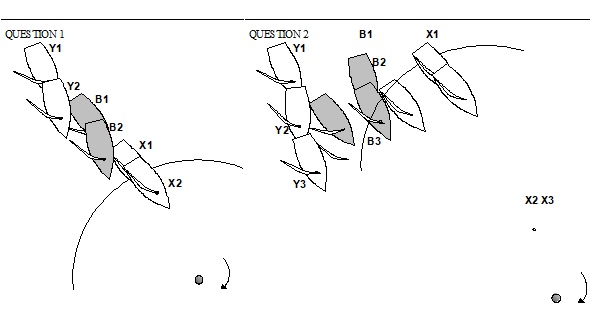


Section H - The Gybe Mark
TR CALL H1
Rule 12, On the Same Tack, Not Overlapped
Rule 18.2, Giving Mark-Room
Rule 19, Room to Pass an Obstruction
Definitions, Room
Definitions, Mark-Room
Question 1
Three boats B, X and Y, all on port tack, are approaching a gybe mark directly astern
of each other. X enters the zone clear ahead of B, and then stops just inside the zone.
Y bears away onto a course to pass to leeward of B. B then bears away to pass to
leeward of X, and Y and B become overlapped. When Y and B become overlapped, B
is no longer able to pass to windward of X. Y bears away to avoid B and protests. What
should the call be?

Answer 1
No penalty.
X is initially an obstruction to B and Y because they are both required to keep clear of
her under rule 12. Also B and Y must each give X mark-room under rule 18.2(b). At
position 1, B has right of way over Y and rule 19.2(a) allows her to pass the obstruction
X on either side. When B and Y become overlapped, Y must give room to B under rule
19.2(b) including space for B to give mark-room to X.
Once the boats become overlapped to leeward of X, right of way changes and X is no
longer an obstruction to B and Y. However, because B and Y are required to give X
mark-room and have now become overlapped inside X, rule 18.2(c)(2) requires B and
Y to give room for X to sail her proper course.
See also call F2.
Question 2
If B and Y are overlapped when B reaches the zone of the mark, how does this limit
the boats’ actions?
Answer 2
B and Y are required to give X mark-room under rule 18.2(b). Y must also give B room
to pass between her and X because X is an obstruction until B becomes overlapped to
leeward of X (see answer 1 above).
When B enters the zone, she is overlapped outside Y and rule 18.2(b) requires her to
give Y mark-room, whether or not the overlap between them is subsequently broken.
If B has been unable to give mark-room from the time the overlap began, she is not
required to give mark-room, see rule 18.2(f). However, if B is able to give Y markroom
by slowing and then luffing astern of X, rule 18.2(f) will not apply and, if B fails
to do so, she will break rule 18.2(b).
The presence of X may mean both B and Y have to pass the wrong side of the mark.
A boat racing is an obstruction for other boats if and only if they are required to keep
clear of her.






